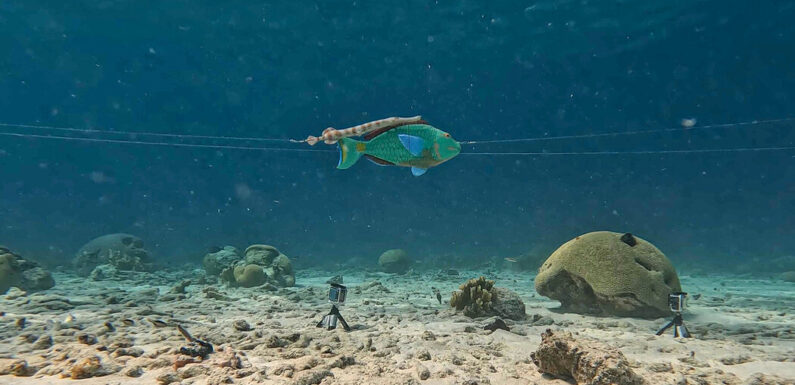
Trumpetfish like to snack on damselfish and shrimp in coral reefs and sea grass beds around the world. But with 20-inch long bodies and conspicuously large snouts, they need tricks to sneak up on their prey.
In a study, published on Monday in the journal Current Biology, scientists demonstrated the effectiveness of one trumpetfish strategy — hiding behind a larger, friendlier fish. The subterfuge of such a fake out seems almost human in its cleverness, leading scientists to wonder whether other species are also making use of similar hunting strategies.
While many coral reef residents, such as groupers and moray eels, work together when hunting for their mutual benefit, the trumpetfish’s sneaky shadowing of larger fish seems to be solely for its own benefit.
It’s also not the trumpetfish’s only means of catching prey off guard. It can change color to blend into its surroundings or disguise itself as inanimate objects like a stick or seaweed. It can also attack from above, hanging vertically in the water column and darting down to suck prey into its gaping mouth.
However, hiding behind a larger nonpredatory fish, such as a parrotfish, until its prey is within striking range seems to be one of its favorite hunting strategies.
“For the last couple of decades, guidebooks, dive blogs and a couple of research papers have documented observations of this behavior,” said Sam Matchette, a behavioral ecologist at the University of Cambridge and an author of the new study.
Historically, humans have employed a similar strategy when hunting waterfowl. Hunters would hide behind “stalking horses,” which were horses or cattle, when approaching ducks to prevent the birds from seeing them and being spooked. Many hunters still use this strategy, but instead of farm animals they use blinds and cardboard cutouts.
Dr. Matchette heard reports that trumpetfish hid behind larger nonpredatory fish when hunting, and the tactic sounded strikingly similar to the stalking horse strategy used by humans. So last year, Dr. Matchette and his colleagues set out to see whether they could prove that trumpetfish were truly doing something much like that used by duck hunters of old.
To test their hypothesis, the researchers made 3D-printed models of trumpetfish and parrotfish and put them on a wire pulley system that they set up near a colony of damselfish on a coral reef off Curaçao. The researchers then pulled the fake fish along the wire, together and one at a time, and filmed the reaction of the damselfish.
When the trumpetfish model was pulled along the wire, the nearby damselfish swam up to inspect it but then quickly fled, clearly perceiving it as a threat. When presented with the parrotfish model, however, the damselfish swam up to inspect it but otherwise did not react to its presence. Similarly, when the trumpetfish model was attached to the side of a parrotfish model and pulled past the damselfish, the fish did not flee.
“Although fish biologists have known about this for a long time, this is the first time someone actually made an experiment that demonstrated how much of an advantage this strategy gives the trumpetfish,” said Luiz Rocha, the curator of ichthyology at the California Academy of Sciences.
This stalking horse strategy is highly effective, Dr. Rocha said, adding that there are probably many other nonhuman animals using it. “I would be really surprised if there aren’t,” he said.
Dr. Matchette said he agreed. “There are probably more examples out there, but we have yet to see them,” he said.
He also suggested that as coral reefs around the world degrade because of a changing climate, stalking horse behavior could become more prevalent. With fewer corals to hide in, using your larger neighbors as cover could become the norm for reef predators.
Source: Read Full Article


